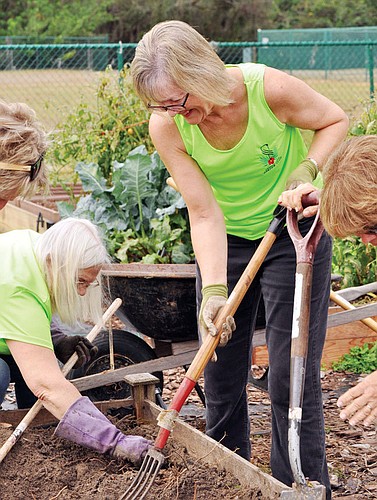- April 19, 2024
-
-
Loading

Loading

The 32 plots inside Lakewood Ranch’s community garden took a beating last year. Between Hurricane Irma and the January cold front, the 70-by-70-foot vegetable patch just couldn’t seem to catch a break.
Yet, somehow it did.
By mid-January, heads of broccoli and cauliflower were popping out of the ground, enveloped in beautiful layers of foliage. Carrots were peeking out of the soil. Pea plants were scaling trellises. Lettuce in all shapes and colors had cropped up in perfect bunches.
Despite 30-degree temps and Irma’s wrath four months earlier, the 3-year-old community garden blossomed this spring — leaner in some plots, greener in others.
“The peppers, tomatoes and peas got zapped,” said Lori Walker, a Greenbrook resident and president of the Lakewood Ranch Garden Club. “The plants from the night shade family were the most affected by the cold. They were more windblown than anything. The rest of the plants did fine — especially the lettuce.”
Not surprisingly, the plants that best survived the arctic blast were root vegetables, romaine lettuce and herbs. If ever there was the perfect time to pick parsley and dill in East Manatee County, January was it.
On a warm Thursday morning, Walker and four members of the Lakewood Ranch Garden Club gather at a raised garden bed to till the soil and dig out stubborn asparagus roots and old chard. With nary a complaint, save for some nagging back pain, they heave shovelfuls of dirt into a wheelbarrow, clawing their hands and pitchforks through the gnarled roots and soil.
“I always say dirt is what’s under your bed and soil is what’s in your garden,” Walker says, ramming her shovel into the ground. “This stuff here is dirt.”
The club inherited the space from a plot owner who could no longer tend it. After plowing through the soil for an hour, the women decide the dirt is too dense to be used for replanting. Roots need space to breathe. Peat and perlite — those small white particles in bagged potting soil — will need to be added to the ground to keep it from getting too compacted, along with composted cow manure for additional nutrients.
“Those asparagus roots need to be covered up,” Walker says. “We’re thinking 3 inches of newspaper and cardboard will make a good barrier. We don’t want those things coming back.”
The Lakewood Ranch Garden Club means business.
Now in its 11th year, the club consists of 52 members, most of whom are women. They meet the second Monday of every month at Lakewood Ranch Town Hall, where they also maintain a Florida-friendly native garden.
When the community garden went in at Greenbrook Adventure Park three years ago, the organization was tapped to help manage it. “We’re like the overseers,” Walker says. “We’re the get-er-done gals.”
The club doesn’t like to waste plot space on plants that are fickle or non-edible. They prefer to grow vegetables they can donate to people who need them. Last year, they grew enough carrots to fill a 50-gallon basin. They donated this bounty — and all other remaining greens and veggies — to Stillpoint House of Prayer, a food pantry in Bradenton, and persuaded the community garden’s other plot owners to do the same.
“They don’t get fresh anything there,” Walker says. “So we try to grow things with a high production volume.”
The garden is located next to Greenbrook’s Paw Park. The land was donated, along with $4,000 in seed money, by Community Development District 4, which serves the Greenbrook neighborhood.
Joe Sidiski, a District 4 board member, spearheaded the project hoping it would encourage camaraderie among residents, especially those from northern and Midwestern states, where summer vegetable gardens are a source of pride.
“I’m from Long Island,” Sidiski says. “I had a garden for many years. I tried growing vegetables down here, and it wasn’t exactly a glowing success. I felt like we needed a garden that could be a showpiece for the community, and a place for people to interact and bond.”
The project launched with 24 plots, priced at $25 a year for Phase 1 residents and $40 a year for everyone else. The spaces were quickly claimed and divided into 4-by-8-foot beds that each plot owner was responsible for building and maintaining. Eight more beds went in last year, of which only one is still available.
The space is being used as a teaching tool for some families; children are helping their parents and grandparents plant in the fall and harvest in the spring. Walker helped some kids in her neighborhood plant okra over the summer. The stalks were almost over her head when Hurricane Irma hit and flooded the park.
“The okra was the only plant sticking out of the water,” Walker says. “You’d have to scuba dive out there to get it.”
A washout was inevitable. After all, the garden sits on a floodplain. “We knew it was a possibility,” Sidiski says. “The Culverhouse Community Garden (in Sarasota) is on a floodplain too. Fortunately, most people don’t plant much in the summer because of the heat, so you don’t often lose a lot of plants when storms come through.”
Although Sidiski doesn’t personally own a plot, he and his wife often pass by the garden on their way to Adventure Park. He says his original vision included a tool shed and a picnic table, but he’s yet to convince board members these amenities are worth the price.
“They’re a pretty dedicated group,” Sidiski says of the plot owners. “On a Saturday or Sunday morning, I’ll see a dozen of them in every corner, cleaning and tidying. I’m not surprised the garden is looking good despite the weather. It’s developing exactly how I hoped it would.”
I felt like we needed a garden that could be a showpiece for the community, and a place for people to interact and bond.” -Joe Sidiski